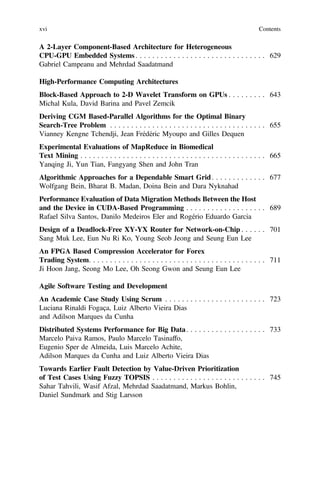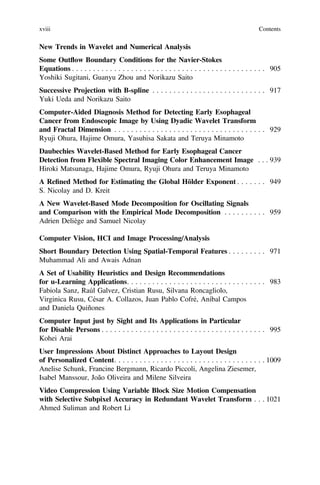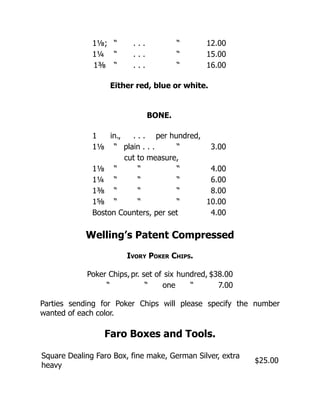Information Technology New Generations 13th International Conference on Information Technology 1st Edition Shahram Latifi (Eds.)
Information Technology New Generations 13th International Conference on Information Technology 1st Edition Shahram Latifi (Eds.)
Information Technology New Generations 13th International Conference on Information Technology 1st Edition Shahram Latifi (Eds.)


























![4 M. Eltayeb and M. Dawson
services for personal use. In this paper, we refer to PCC as the private and hybrid
cloud computing for the individual user’s usage. PCC has emerged as a new para-
digm model for individual users. It has transformed the user’s computer device
from being device-centric to information-centric [1-7]. PCC enables individuals to
share music, photos, videos, documents, and applications using any computer
devices connected to the network. It provides portable access from anywhere in
the world to information held centrally.
Though PCC demonstrated great potential in terms of scalability and agility,
and is therefore enjoying great popularity and attention, storing data and applica-
tions in the cloud is becoming very risky [8]. Many cloud users have become con-
cerned about security and protection of privacy [9], perhaps not surprisingly as the
cloud functions to store and share private data [10]. The main challenge and dis-
advantage users see in the adoption of cloud computing is that they lack full con-
trol over the hardware [11]. There are, therefore, several issues related to privacy
and security that must be addressed before PCC can be considered reliable.
Very often, data stored in the cloud is seen as valuable to those with malicious
intent [12]. Storing data and applications in the cloud is becoming very risky. It is
very important for users to take personal precautions in order to secure personal,
sensitive information—information they would have stored in their local computer
device (laptop, desktop, phone, tablet, etc.), and now store in the cloud. It is criti-
cal for users to understand the security measures that the cloud provider has in
place [13].
Predicting technology usage and adoption has become a topic of mainstream
study [14]. The rapidly growing importance of technologies has led researchers to
study user technology acceptance intensively. Negative attitudes toward a tech-
nology, its ease of use, and its usefulness may negatively impact the success of
that technology. Indeed, several IT scholars considered the user’s acceptance of a
technology to be the key success factor for the adoption of that technology [15].
The remaining of the paper is organized as follows: in the next section, we pre-
sent the objectives of the study. Section 2 discusses and articulates our theoretical
framework. Section 3 presents the research questions and hypothesis. The popula-
tion sample information are discussed in section 4. A detailed discussion of
the study’s data collection and validation are provided in section 5. Section 6
discusses the data analysis of the study.
Section 5 presents methods used for data collections. Section 6 discusses the
data analysis. Section 7 discusses our findings; and additional findings are dis-
cussed in section 8. Our recommendation and discussion are presented in section 9.
Finally, section 10 concludes the paper.
2 Theoretical Framework
This research was deductive in nature. Therefore, a quantitative method was
selected to understand user’s acceptance of PCC. In particular, a non-experimental
quantitative approach was used. The theoretical framework utilized in this study](https://image.slidesharecdn.com/7289-250614230959-f327b918/85/Information-Technology-New-Generations-13th-International-Conference-on-Information-Technology-1st-Edition-Shahram-Latifi-Eds-27-320.jpg)
![Understanding User’s Acceptance of Personal Cloud Computing 5
was based on TAM—a widely recognized model in the field of IT, introduced by
Davis in 1986 [16]. Davis [16, 17] recommended TAM as the best model for in-
vestigating end user attitudes towards and acceptance or rejection of a technology.
According to Gao [18], “TAM can serve the purpose of predicting user acceptance
of a technology before the users get heavily involved in the technology and thus is
a cost-effective tool in screening potential candidate systems or programs” (p. 3).
This theoretical framework was used in this study to examine factors influencing
PCC adoption.
TAM proposes two independent variables—perceived ease of use, and perceived
usefulness (PU) of a technology—to predict the user’s attitude toward adopting a
technology [18]. Davis [16, 17] defined PU as the degree to which a user believes
that the adoption of a particular technology will improve the performance of his or
her job. The perceived ease of use, on the other hand, is the degree to which a user
believes that using a particular technology would be effortless [17].
Since the purpose of this study was to understand users’ thoughts, experiences,
expectations, and security concerns with respect to the adoption of PCC, TAM was
found to be the most suitable theoretical approach due to its validity and reliability in
exploring and explaining users’ attitudes toward using technologies [16]. Cloud
computing is a new approach to computing [19], and as new technologies are intro-
duced and are adopted, concerns and challenges emerge [20]. Therefore, this study
on PCC technology has a legitimate place in research on user technology
acceptance.
This research study extended TAM to include attitude towards using (ATU) as
an additional independent variable. This study adapted a survey instrument tested
by Davis [16], and validated by Venkatesh [21]. Overall, this study included three
independent variables and one dependent variable. The independent variables are
perceived ease of use (PEOU), attitude toward using PCC (ATU) and perceived
usefulness of PCC (PU). One dependent variable—Intention to Use PCC (ITC)—
was used broadly in this study.
3 Research Questions and Hypothesis
3.1 Research Question 1: How Does Perceived Ease of Use
Influence the Acceptance of PCC?
H1A: Perceived ease of use positively influences attitude toward the acceptance of
PCC.
H10: Perceived ease of use has no correlation to attitude toward the acceptance of
PCC.](https://image.slidesharecdn.com/7289-250614230959-f327b918/85/Information-Technology-New-Generations-13th-International-Conference-on-Information-Technology-1st-Edition-Shahram-Latifi-Eds-28-320.jpg)

![Understanding User’s Acceptance of Personal Cloud Computing 7
A total of 464 participants were randomly chosen to participate in the study.
However, only 399 of the chosen participants fully completed the survey; 20 par-
ticipants opted out and 45 were disqualified either with unanswered questions or
with providing partial data. Only fully completed responses were admitted. There
was a 95.69% completion rate of surveys. Thus, the number of completed responses
exceeded the estimated, representative minimal sample size of 384. Several items in
the survey—gender, age range, education, state, and census region—were included
to further describe demographic characteristics of the sample.
5 Data Collection and Validation
This study used a web survey to collect data from participants. The survey was
hosted by SurveyMonkey.com, which is considered one of the leading providers
of online survey solutions. The identity of participants was kept confidential and
anonymous. Participant had the right to withdraw from participation at any time.
Participants were required to complete a consent form as soon as they login to the
SurveyMonkey.com. The consent form store collected information confidentially.
Information collected by the survey included: gender, age range, state of residence,
and level of education.
The survey questions in this study were designed to express a clearly negative
or positive opinion and avoided neutral opinions to solicit more definitive
responses. The researcher transcribed the data collected through Survey Monkey
into digital documents. Data was downloaded by the researcher after the comple-
tion of data collection. Only fully completed surveys were employed in this study.
Some participants were disqualified either with unanswered questions or with
providing partial data. Incomplete responses and partial data were completely
discarded. Additionally, Survey data was assessed for multicollinearity, homosce-
dasticity, linearity, and normality [22].
6 Data Analysis
The multiple regression test was performed as follows: (1) predictors were se-
lected using their semi-partial correlation with the outcome; (2) predictors were
entered into the model based on a mathematical method using Statistical Package
for the Social Sciences (SPSS) Version 19.0; (3) the selection of predictors was
performed in steps [23].
Descriptive statistics, ANOVA, Chi-square, and Multiple regressions were per-
formed to explore the relationship between the continuous dependent variable
(ITU) and independent variables (PEOU, PU, and ATU). Several descriptive sta-
tistics techniques were used to depict the sample population characteristics.
ANOVA was used to analyze both dependent and independent variables. In addi-
tion, the multiple regression test was performed to assess the impact of each
independent variable (PU, PEOU, and ATU) on the dependent variable (ITU).](https://image.slidesharecdn.com/7289-250614230959-f327b918/85/Information-Technology-New-Generations-13th-International-Conference-on-Information-Technology-1st-Edition-Shahram-Latifi-Eds-30-320.jpg)
![8 M. Eltayeb and M. Dawson
7 Findings
TMultiple regressions were performed to explore the relationship between the
continuous dependent variable (ITU) and independent variables (PEOU, PU, and
ATU). This research study tested the relationship between perceived ease of use,
usefulness, attitude toward using PCC, and the acceptance of PCC. The model’s
adequacy was tested in terms of normality, linearity, and collinearity [24].
7.1 First Regression Model
The first regression was performed to determine the relationship between the in-
dependent variable PEOU and the dependent variable ITU. Six predictors of the
independent variable PEOU were tested to address the first research question. The
relationship between the predictors and the outcome were measured using a step-
wise method, so that the unique contribution of each predictor could be assessed to
explain variance of the outcome [24]. The following research question and
hypothesis were tested at this stage:
How does perceived ease of use influence the acceptance of PCC?
H10: Perceived ease of use has no correlation to the acceptance of PCC.
The results of the regression analysis demonstrated a positive correlation between
PEOU and the acceptance of PCC. It was found that approximately 23.5% of the
variance in the acceptance of PCC can be accounted for by PEOU. Therefore, the
null hypothesis was rejected and the alternative was supported.
This result is consistent with other studies showing that there is a positive cor-
relation between PEOU and the user’s acceptance of a technology. Davis [16]
argued that perceived ease of use positively influence attitude toward using a
technology. Perceived ease of use plays an important role in determining and pre-
dicting the user’s intention to use a technology [25]. Ramgovind [26] stated “The
success of modern day technologies highly depends on its effectiveness of the
world’s norms, its ease of use by end users and most importantly its degree of
information security and control” (p. 1).
7.2 Second Regression Model
The second regression was performed to determine the relationship between the
independent variable PU and the dependent variable ITU. Five predictors of the
independent variable PU were tested to address the first research question.
A stepwise regression was performed to build the model. The unique contribution
of each predictor was measured to explain the variance of the outcome [24]. The
following research question and hypothesis were tested at this stage:](https://image.slidesharecdn.com/7289-250614230959-f327b918/85/Information-Technology-New-Generations-13th-International-Conference-on-Information-Technology-1st-Edition-Shahram-Latifi-Eds-31-320.jpg)
![Understanding User’s Acceptance of Personal Cloud Computing 9
How does perceived usefulness of PCC influence the acceptance of PCC?
H20: Perceived usefulness has no correlation to attitude toward the acceptance of
PCC.
The results of the regression analysis demonstrated a positive correlation between
PU and the acceptance of PCC. It was found that approximately 78.2% of the
variance in the acceptance of PCC can be accounted for by PU. Therefore, the null
hypothesis was rejected and the alternative was supported. This result is consistent
with other studies showing that there is a positive correlation between PU and the
user’s acceptance of a technology.
7.3 Third Regressions Model
The third regression was performed to determine the relationship between the
independent variable ATU and the dependent variable ITU. Four predictors of
the independent variable ATU were tested to address the first research question.
The relationship between the predictors and the outcome were measured using
stepwise regression. The unique contribution of each predictor was measured to
explain the variance of the [24]. The unique contribution of each predictor is
measured to explain the variance of the outcome. The following research question
and hypothesis were tested at this stage:
How does attitude toward using PCC influence user’s acceptance of PCC?
H30: There will be no correlation between attitude toward using PCC and user’s
acceptance of PCC.
The independent variable ATU was used for determining the degree in which
there is a correlation between attitude toward using PCC and users’ intention to
use. The results of the regression analysis demonstrated a significant correlation
between ATU and the acceptance of PCC. It was found that approximately 38.2%
of the variance in the acceptance of PCC can be accounted for by ATU. Therefore,
the null hypothesis was rejected and the alternative was supported.
8 Additional Findings
Statistically significant differences were found between age group means, as indi-
cated by results of the one-way ANOVA (F (5, 2.801)=2.801, p=.017). The output
result of the one-way ANOVA showed that the age group significantly contributed
to the variation in the respondent’s acceptance of the PCC technology. Because
the output result of the one-way ANOVA test demonstrated significant differences
between the age groups, a Post Hoc test was conducted to further investigate
which means were significantly different from each other. The Post Hoc test result](https://image.slidesharecdn.com/7289-250614230959-f327b918/85/Information-Technology-New-Generations-13th-International-Conference-on-Information-Technology-1st-Edition-Shahram-Latifi-Eds-32-320.jpg)



























